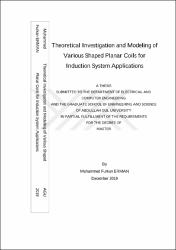| dc.contributor.author | ERMAN, MUHAMMED FURKAN | |
| dc.date.accessioned | 2020-07-22T10:57:46Z | |
| dc.date.available | 2020-07-22T10:57:46Z | |
| dc.date.issued | 2019 | en_US |
| dc.identifier.other | Tez No: 609257 | |
| dc.identifier.uri | https://hdl.handle.net/20.500.12573/335 | |
| dc.description.abstract | Heating occupies an important place in industry. With the development of technology, in today’s world there are different kinds of heating methods that are being widely used including resistive and infrared heating, etc. Among these methods, induction heating is increasingly becoming more popular. One of the most important parts of induction heating systems is coil. Coil creates magnetic field when electrical power is applied on and current flows through it. It is possible to see different coil shapes in industry such as circular and square shapes, etc. Analytical investigation of these coil shapes is possible by using existing formulas in the literature. However, due to the production difficulties of sharp corners or on purpose, it is inevitable to face rounded corners in coil geometries having sharp corners such as square shaped coils, which is called squircle coil when its corners are rounded. Since coil shape is different than its original form, magnetic flux density created at the center of the coil is not the same. In this study, a gap in literature is filled with derivation of required formulas to examine such coils analytically. Obtained derivations were verified by calculating magnetic flux densities created by squircle and triangular shaped coils. For each coil shape simulations were repeated for two different cases. Similarly, for each case simulations were renewed for three different coil sizes, and for each size 5 different amounts of rounding were selected. In the first case, arcs are assumed to be parts of a circle whose center is coinciding with the center of the coil. In case 1, magnetic flux densities created by coils are calculated by using both proposed and traditional formulas. In the second case, on the other hand, arcs are set to be parts of circles positioned at different locations such that their centers do not coincide with the coil center. In case 2, total length of the coil for vii different amounts of rounding was kept constant to see the effect of the rounding on created magnetic field density. Also, calculations in this case are obtained by using only the proposed method. After calculations of magnetic flux densities, results were supported with three-dimensional electromagnetic simulations. Comparison of the results found with analytical calculations and simulations show that the maximum error between the proposed method and traditional method; and the maximum error between the proposed method and simulations are both less than 1%. | en_US |
| dc.language.iso | eng | en_US |
| dc.publisher | Abdullah Gül Üniversitesi | en_US |
| dc.rights | info:eu-repo/semantics/openAccess | en_US |
| dc.subject | Induction Heating | en_US |
| dc.subject | Squircle Coil | en_US |
| dc.subject | Triangular Coil | en_US |
| dc.subject | Magnetic Flux Density | en_US |
| dc.subject | Rounded Corner | en_US |
| dc.title | Theoretical investigation and modeling of various shaped planar coils for induction system applications | en_US |
| dc.title.alternative | İndüksiyon sistemi uygulamaları için farklı düzlemsel bobin şekillerinin teorik olarak incelenmesi ve modellenmesi | en_US |
| dc.type | masterThesis | en_US |
| dc.contributor.department | AGÜ, Fen Bilimleri Enstitüsü, Elektrik ve Bilgisayar Mühendisliği Ana Bilim Dalı | en_US |
| dc.contributor.institutionauthor | ERMAN, MUHAMMED FURKAN | |
| dc.relation.publicationcategory | Tez | en_US |


















